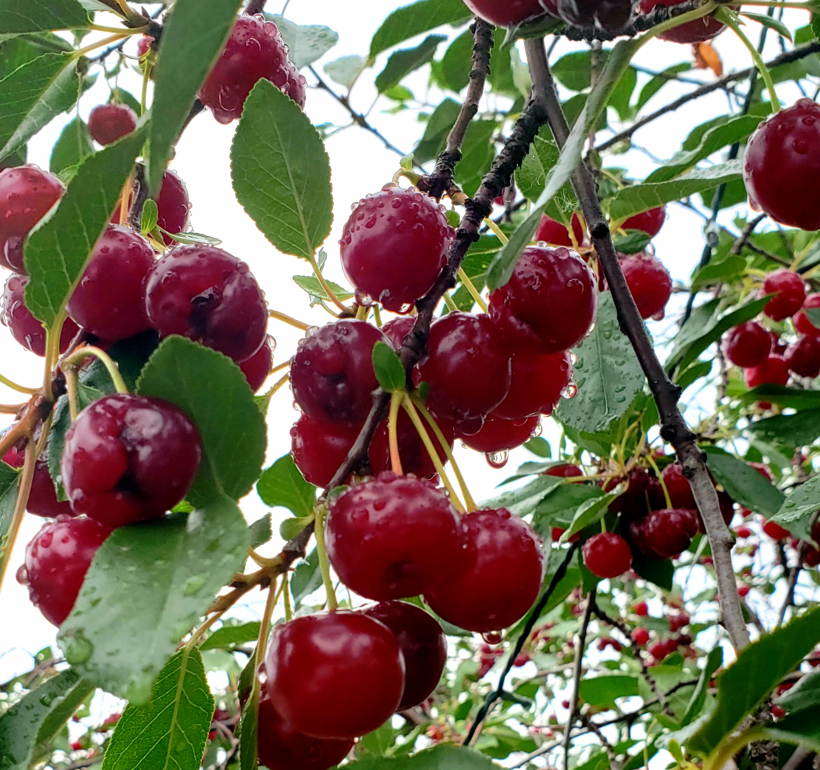Among some of the fruits like apples that are hardy enough to grow on the prairies, we can also grow cherries here.
Prairie Cherries (Dwarf Sour Cherries) are one of my favourite fruits to grow. The shrubs are spectacular in bloom and even more enticing when the fruit is ripening. In order to understand how this fabulous fruit was developed, it is necessary to understand a little bit of fruit breeding history. Thousands of years ago, the sweet cherry (Prunus avium) was crossed with the Mongolian cherry (Prunus fruiticosa) which resulted in the sour cherry (Prunus cerasus). During the 20th Century, much breeding has occurred to increase the cold hardiness of the sour cherry, which results in better survival in colder areas (like ours). For over 60 years there have been many, many people involved in the quest to develop a successful cherry for our region. For those involved with these breeding programs the fabulous dwarf sour cherry is often fondly referred to as the prairie cherry!
The dwarf sour cherry (Prunus cerasus) is truly a dwarf sour cherry and is not grafted but grows on its own rootstock. In 1999, ‘SK Carmine Jewel’ was released after many years of work by people in the Horticulture branch of the University of Saskatchewan as a dwarf sour cherry cultivar. It is a very attractive shrub with glossy leaves and reaches a height of about 2 metres (6.5 feet). Each spring you will be rewarded with a showy bloom. The flowers are white and large and look spectacular against the glossy green foliage. The fruit when ripe has a dark purple skin and flesh and has a small pit in relation to the fruit size. It matures in late July or early August.
From this first cultivar, more have followed. The Romance series of cherries, which include: ‘Cupid’, ‘Romeo’, ‘Juliet’, ‘Valentine’, and ‘Crimson Passion’. All of these cherries are slightly different in size of both the plant and the fruit itself. My personal favourite of all the cherries is “Juliet’ as the cherry is very sweet and larger, making it easier to pit. If you can bear to leave the fruit on the tree until that bright red cherry colour deepens to a dark maroon, the cherries will be much sweeter.
After growing this cherry and a number of other cultivars, a few things have become apparent. They do sucker which makes them less attractive due to increased maintenance. I have found that the Romance series of cherries do sucker more rapidly than the original cultivar 'SK Carmine Jewel'.

The cherries also have more disease issues than they had originally. This is expected, as pests and diseases thrive with many years of successive growth. When conditions are right, my cherries will develop a number of common fungal diseases of stone fruits. Brown rot, which affects most of the stone fruits and occasionally apples when grown in close proximity to stone fruits has been the largest fungal condition I have experienced and unfortunately, this unsightly condition does affect the amount of fruit suitable for harvest.
A secondary concern is to ensure fruit that is picked is appropriately treated to minimize postharvest disease problems. Personally, I like to pick and process in basically the same time frame and usually try to pick when the ambient outside temperature is cool. With any harvesting it is important to reduce the temperature of the produce quickly to maximize the quality of the produce. Also equally important is to minimize the exposure of fruit to twigs, leaves and other debris, which could harbor spores or other disease causing factors.
Our harvesting practice is to pick and pit simultaneously to avoid fruit loss. We simply use a home-style cherry pitter made by Westmark which is actually very efficient and easy to use. I have used it for many years and it just keeps on pitting. The other alternative is to juice the cherries. For this process, we either put the fresh cherries through a fruit press either fresh or frozen. We have found that the best way to do this is to rent a commercial wine press used for making wine rather than a domestic tabletop juicer. Just for the record, five years ago we had such a bumper crop of cherries that we made a couple of carboys of cherry wine. After five years, it has aged into a lovely flavourful, dry red wine.
Hanbidge is the Lead Horticulturist with Orchid Horticulture. Find us at www.orchidhort.com; by email at [email protected]; on Facebook @orchidhort and on Instagram at #orchidhort.
Tune into GROW Live on our Facebook page or check out the Youtube channel GROW.




